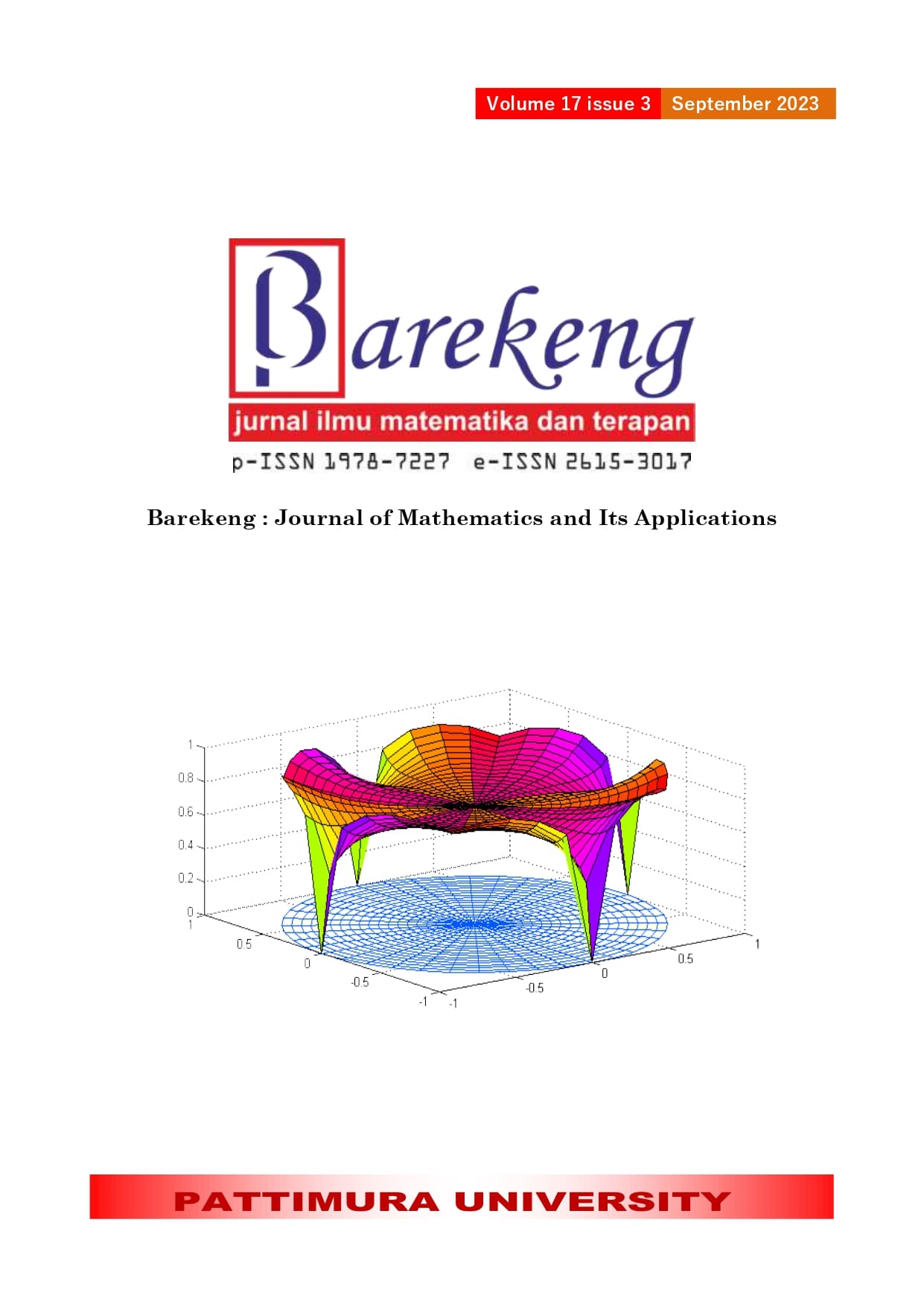ANALYSIS OF SOCIO-ECONOMIC IMPACTS OF THE COVID-19 PANDEMIC USING FACTOR ANALYSIS
Abstract
The purpose of this study is to identify the factors that influence the socio-economic impact of the Covid-19 pandemic. This study uses explanatory factor analysis that is an analysis that forms new random factors in which the later formed factors or constructs can be interpreted. The case study was conducted in Sawan Village, Sawan District, Buleleng Bali, with six variables explaining the economic impact, and 16 variables explaining the social impact. The results of the study show that there are three factors that explain the economic impact due to Covid-19. They are the income factor, the purchase of quotas and gadgets, and the expenditure factor with the total variance described being 82,178 percent. Meanwhile, the social impact due to the Covid-19 pandemic is explained by three factors, namely the fear of interacting in public places, the fear factor of doing activities outside the home, and the fear of using public facilities with a total variance that can be explained is 73,609 percent.
Downloads
References
S. Dryhurst et al., “Risk perceptions of COVID-19 around the world,” J. Risk Res., vol. 23, no. 7–8, pp. 994–1006, Aug. 2020, doi: 10.1080/13669877.2020.1758193.
C.-C. Lai, T.-P. Shih, W.-C. Ko, H.-J. Tang, and P.-R. Hsueh, “Severe acute respiratory syndrome coronavirus 2 (SARS-CoV-2) and coronavirus disease-2019 (COVID-19): The epidemic and the challenges,” Int. J. Antimicrob. Agents, vol. 55, no. 3, p. 105924, Mar. 2020, doi: 10.1016/j.ijantimicag.2020.105924.
J. Moudy and R. A. Syakurah, “Pengetahuan terkait usaha pencegahan Coronavirus disease (COVID-19) di Indonesia,” Higeia J. Public Health Res. Dev., vol. 4, no. 3, pp. 333–346, 2020, doi: 10.15294/higeia/v4i3/37844.
C. Morlotti and R. Redondi, “The impact of COVID-19 on airlines’ price curves,” J. Air Transp. Manag., vol. 107, p. 102328, Mar. 2023, doi: 10.1016/j.jairtraman.2022.102328.
M. Ando and K. Hayakawa, “Impact of COVID-19 on trade in services,” Jpn. World Econ., vol. 62, p. 101131, Jun. 2022, doi: 10.1016/j.japwor.2022.101131.
G. Allan, K. Connolly, G. Figus, and A. Maurya, “Economic impacts of COVID-19 on inbound and domestic tourism,” Ann. Tour. Res. Empir. Insights, vol. 3, no. 2, p. 100075, Nov. 2022, doi: 10.1016/j.annale.2022.100075.
O. Soliku, B. Kyiire, A. Mahama, and C. Kubio, “Tourism amid COVID-19 pandemic: impacts and implications for building resilience in the eco-tourism sector in Ghana’s Savannah region,” Heliyon, vol. 7, no. 9, p. e07892, Sep. 2021, doi: 10.1016/j.heliyon.2021.e07892.
W. A. F. Dewi, “Dampak Covid-19 terhadap implementasi pembelajaran daring di sekolah dasar,” J. Ilmu Pendidik., vol. 2, no. 1, pp. 55–61, Apr. 2020.
M. Hosen, M. N. Uddin, S. Hossain, M. A. Islam, and A. Ahmad, “The impact of COVID-19 on tertiary educational institutions and students in Bangladesh,” Heliyon, vol. 8, no. 1, p. e08806, Jan. 2022, doi: 10.1016/j.heliyon.2022.e08806.
G. Di Pietro, “The impact of Covid-19 on student achievement: Evidence from a recent meta-analysis,” Educ. Res. Rev., vol. 39, p. 100530, May 2023, doi: 10.1016/j.edurev.2023.100530.
R. Rodríguez-Rey, H. Garrido-Hernansaiz, and S. Collado, “Psychological impact and associated factors during the initial stage of the Coronavirus (Covid-19) pandemic among the general population in Spain,” Front. Psychol., vol. 11, 2020, [Online]. Available: https://www.frontiersin.org/articles/10.3389/fpsyg.2020.01540
M. Varshney, J. T. Parel, N. Raizada, and S. K. Sarin, “Initial psychological impact of COVID-19 and its correlates in Indian Community: An online (FEEL-COVID) survey,” PLOS ONE, vol. 15, no. 5, p. e0233874, May 2020, doi: 10.1371/journal.pone.0233874.
K. Gladwin and M. Duncan, “COVID-19′s impact on older adults’ cycling behaviors in a small, auto-centric urban area,” Transp. Res. Interdiscip. Perspect., vol. 16, p. 100675, Dec. 2022, doi: 10.1016/j.trip.2022.100675.
R. N. Azimah, I. N. Khasanah, R. Pratama, Z. Azizah, W. Febriantoro, and S. R. S. Purnomo, “Analisis dampak Covid-19 terhadap sosial ekonomi pedagang di Pasar Klaten dan Wonogiri,” Empati J. Ilmu Kesejaht. Sos., vol. 9, no. 1, pp. 59–68, 2020, doi: 10.15408/empati.v9i1.16485.
J. F. Jr. Hair, W. C. Black, B. J. Babin, and R. E. Anderson, Multivariate Data Analysis, Eighth. Hampshire: Cengage, 2019.
R. A. Johnson and D. W. Wichern, Applied Multivariate Statistical Analysis, Sixth edition (Pearson modern classic edition). Upper Saddle River, New Jersey: Pearson, 2019.
C. Andrade, “The inconvenient truth about convenience and purposive samples,” Indian J. Psychol. Med., vol. 43, no. 1, pp. 86–88, Jan. 2021, doi: 10.1177/0253717620977000.
R. Nielsen, S. Villasante, J. M. F. Polanco, J. Guillen, I. Llorente Garcia, and F. Asche, “The Covid-19 impacts on the European Union aquaculture sector,” Mar. Policy, vol. 147, pp. 105361–105361, 2023, doi: 10.1016/j.marpol.2022.105361.
R. D. Anisa, R. Rusdinal, and F. Firman, “Dampak COVID-19 terhadap aktivitas sosial masyarakat di Kota Lubuklinggau,” Syntax Idea Vol 3 No 3 2021 Syntax Idea, 2021, [Online]. Available: https://jurnal.syntax-idea.co.id/index.php/syntax-idea/article/view/1076
Copyright (c) 2023 Made Susilawati, I Wayan Sumarjaya, IGAM Srinadi, DPE Nilakusmawati, NLP Suciptawati

This work is licensed under a Creative Commons Attribution-ShareAlike 4.0 International License.
Authors who publish with this Journal agree to the following terms:
- Author retain copyright and grant the journal right of first publication with the work simultaneously licensed under a creative commons attribution license that allow others to share the work within an acknowledgement of the work’s authorship and initial publication of this journal.
- Authors are able to enter into separate, additional contractual arrangement for the non-exclusive distribution of the journal’s published version of the work (e.g. acknowledgement of its initial publication in this journal).
- Authors are permitted and encouraged to post their work online (e.g. in institutional repositories or on their websites) prior to and during the submission process, as it can lead to productive exchanges, as well as earlier and greater citation of published works.






1.gif)



